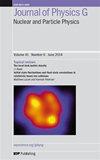影响26Al恒星生成的核反应速率研究进展
IF 3.4
3区 物理与天体物理
Q2 PHYSICS, NUCLEAR
Journal of Physics G: Nuclear and Particle Physics
Pub Date : 2022-10-24
DOI:10.1088/1361-6471/ac9cf8
引用次数: 3
摘要
放射性同位素26Al是银河系和早期太阳系环境中核合成的关键观测物。为了正确地解释各种各样的天文和陨石数据,了解相关恒星上26Al产生的核反应和这些地点的物理特性是至关重要的。这些范围从低质量和中质量渐近巨大分支(AGB)恒星的风;到大质量和超大质量恒星,包括它们的沃尔夫-拉叶风(WR)和最终的核心坍缩超新星(CCSN);新星的喷射物,发生在白矮星表面的爆炸,从伴星中吸积物质。有几个反应会影响这些天体中26Al的产生,包括(但不限于)25Mg(p,γ)26Al、26Al(p,γ)27Si和26Al(n,p/α)。近年来,为了提高我们对这些关键反应的理解,进行了大量的实验工作。本文总结了26Al研究的天体物理动机,回顾了其在不同恒星位置的产生,并及时评估了目前可用的核数据。我们还为恒星模型的核输入提供了建议,并提出了相关的、未来的实验工作。本文章由计算机程序翻译,如有差异,请以英文原文为准。
Progress on nuclear reaction rates affecting the stellar production of 26Al
The radioisotope 26Al is a key observable for nucleosynthesis in the Galaxy and the environment of the early Solar System. To properly interpret the large variety of astronomical and meteoritic data, it is crucial to understand both the nuclear reactions involved in the production of 26Al in the relevant stellar sites and the physics of such sites. These range from the winds of low- and intermediate-mass asymptotic giant branch (AGB) stars; to massive and very massive stars, both their Wolf-Rayet (WR) winds and their final core-collapse supernovae (CCSN); and the ejecta from novae, the explosions that occur on the surface of a white dwarf accreting material from a stellar companion. Several reactions affect the production of 26Al in these astrophysical objects, including (but not limited to) 25Mg(p,γ)26Al, 26Al(p,γ)27Si, and 26Al(n,p/α). Extensive experimental effort has been spent during recent years to improve our understanding of such key reactions. Here we present a summary of the astrophysical motivation for the study of 26Al, a review of its production in the different stellar sites, and a timely evaluation of the currently available nuclear data. We also provide recommendations for the nuclear input into stellar models and suggest relevant, future experimental work.
求助全文
通过发布文献求助,成功后即可免费获取论文全文。
去求助
来源期刊
CiteScore
7.60
自引率
5.70%
发文量
105
审稿时长
1 months
期刊介绍:
Journal of Physics G: Nuclear and Particle Physics (JPhysG) publishes articles on theoretical and experimental topics in all areas of nuclear and particle physics, including nuclear and particle astrophysics. The journal welcomes submissions from any interface area between these fields.
All aspects of fundamental nuclear physics research, including:
nuclear forces and few-body systems;
nuclear structure and nuclear reactions;
rare decays and fundamental symmetries;
hadronic physics, lattice QCD;
heavy-ion physics;
hot and dense matter, QCD phase diagram.
All aspects of elementary particle physics research, including:
high-energy particle physics;
neutrino physics;
phenomenology and theory;
beyond standard model physics;
electroweak interactions;
fundamental symmetries.
All aspects of nuclear and particle astrophysics including:
nuclear physics of stars and stellar explosions;
nucleosynthesis;
nuclear equation of state;
astrophysical neutrino physics;
cosmic rays;
dark matter.
JPhysG publishes a variety of article types for the community. As well as high-quality research papers, this includes our prestigious topical review series, focus issues, and the rapid publication of letters.

 求助内容:
求助内容: 应助结果提醒方式:
应助结果提醒方式:


